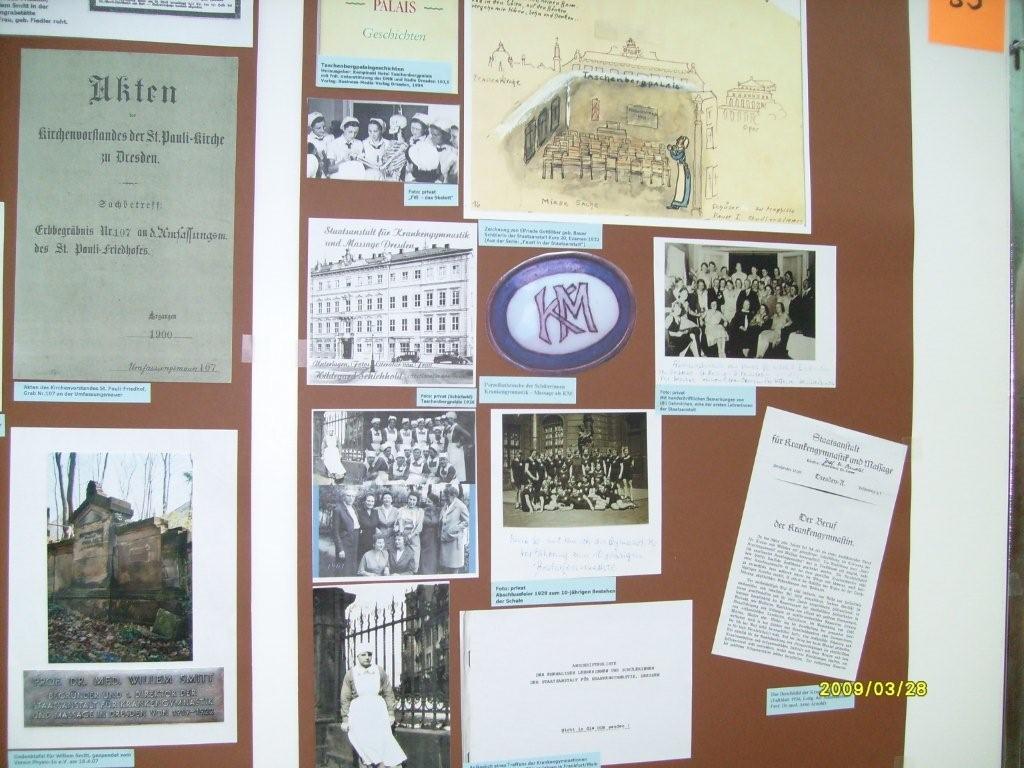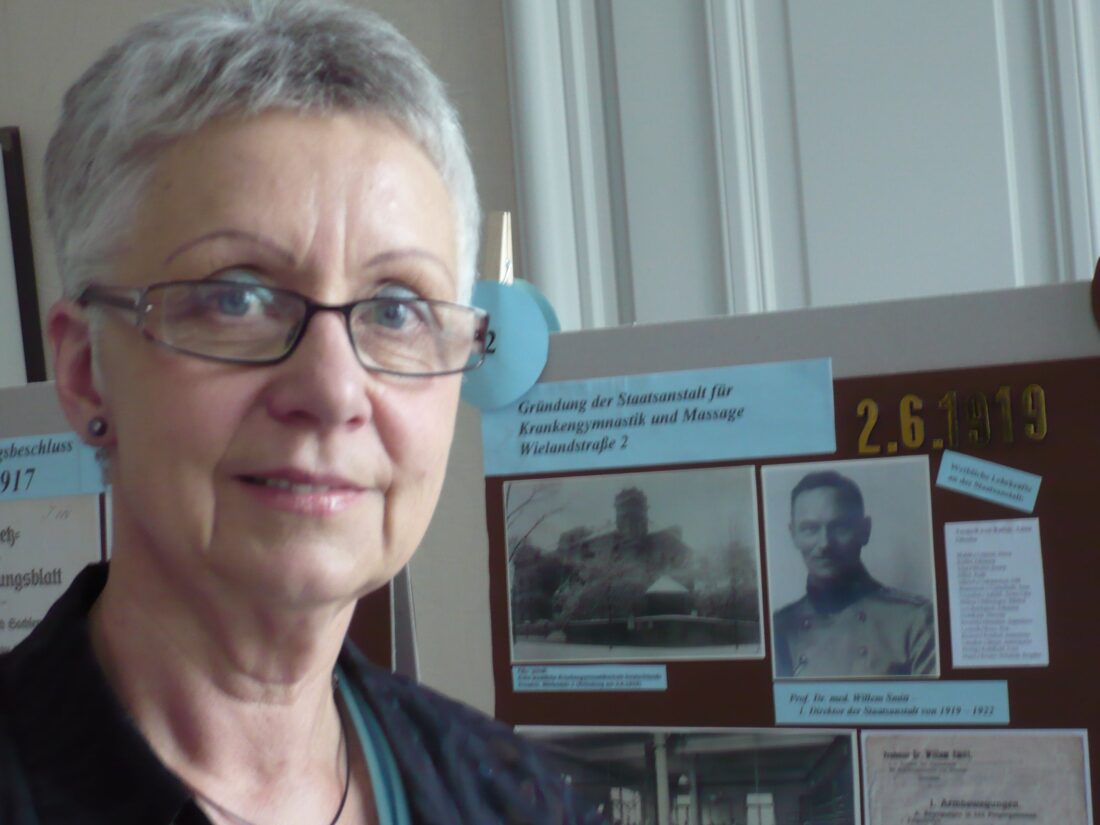An interview with Brigitte Böttcher, former specialist physiotherapist for psychosocial medicine in the German Democratic Republic (GDR).
The distinct historical development of physiotherapy in the German Democratic Republic (1949 to 1990) has been neglected. For this reason, the experiences and memories of witnesses are crucial to learn more about this history of “the other German state”.
Brigitte Böttcher (pictured above) completed her education as a physiotherapist in the GDR in the 1960s at the state technical college at Heinrich Braun Hospital in Zwickau and then worked in the inpatient and outpatient sectors in Dresden for many years. Because of her great interest in the history of physiotherapy in her home region of Saxony and in the GDR in general, she has built up what is probably the largest collection of materials relating to this history in Germany. She was also the initiator of Physio-In e.V., an association concerned with developing new perspectives for community-oriented physiotherapy inspired by historical predecessors.
Dear Mrs Böttcher, thank you for sharing your research on the history of physiotherapy in Saxony and in the former German Democratic Republic with the International Physiotherapy History Association (IPHA).
In the former German Democratic Republic you were a “specialist physiotherapist for prophylaxis and physiotherapy for functional disorders and mental illnesses” (since 1973): What exactly did this specialisation entail and how did you become a specialist physiotherapist?
In 1964, the Central Institute for the Further Training of Intermediate Medical Staff (Zentralinstitut für die Weiterbildung mittlerer medizinischer Fachkräfte) was founded in Potsdam. It reported directly to the Ministry of Health. Under the direction of Brigitte Zeibig, a physiotherapist and qualified medical educator, the training to become a state-recognised specialist physiotherapist was developed. There were four specialisations:
- Prophylaxis and physiotherapy for functional disorders and mental illnesses;
- Children (cerebral disorders);
- Sports medicine; and
- Amputations and limb defects.
In order to attend this training, physiotherapists had to be nominated by their workplace. I was nominated by the Dresden University Polyclinic via the district academies for health and social services. The training included a total of about 500 hours (theoretical lectures by medical doctors or psychologists, and practical hours – mostly in university-affiliated institutions), with an examination and a final thesis. As this was a state-recognised qualification, the certificate led to a higher salary. Through this specialist training, communicative movement therapy and a relaxation method (concentrative relaxation), based on client-centred communication and therapeutic interaction, became part of physiotherapy practice.
For physiotherapists working in inpatient settings, such specialist training held advantages. As a specialist physiotherapist, I was also qualified to work in the area of child and adolescent psychiatry. There were no private physiotherapy practices for outpatients in the GDR. In the polyclinic, I could easily integrate Concentrative Relaxation (“KoE“) into group therapy (e.g. breathing group, back pain group, etc.) from 1973 onwards.
By 1990, there were specialist physiotherapists throughout the GDR. This specialist training was protected in the Unification Treaty between the two German states. However, physiotherapy services in the psychosomatic/psychiatric field were not included in the catalogue of remedies that regulated the reimbursement of health services for the whole of unified Germany from 1990 onwards. Physiotherapists in the new federal states still continued to be trained in basic and advanced courses in “Concentrative Relaxation” through the regional associations of the German Physiotherapy Association (ZVK) until around 2012. In 2007, the Health Professions‘ Training Act led to an initiative with the Ministry of Social Affairs in Saxony, which resulted in a new legally recognised training as a “specialist physiotherapist for psychosocial medicine” in Saxony. As this state law is not compatible with German federal law, the implementation of this specialist physiotherapist has not been possible to date for legal reasons, so services provided are not covered by the catalogue of remedies and thus not reimbursed by the statutory health insurance.
How do you see the collaboration between doctors and physiotherapists? What was your own experience and what kind of development would you like to see in the future?
In the GDR, cooperation with doctors was a matter of course, obviously dictated by central control. This was made easier by the fact that physiotherapists were integrated as associate members in the medical societies (e.g. in the Medical Society for Orthopaedics, for Physical Therapy or for Psychotherapy). There were productive encounters at congresses as medical and physiotherapeutic perspectives were jointly addressed in the lectures. In today’s debate about the independence of physiotherapists through academisation, the professional relationship between doctor and physiotherapist or psychotherapist and physiotherapist should be addressed. At present, for legal reasons, referring to the doctor’s diagnosis is the role of the physiotherapist, from which a right to propose therapeutic “techniques and strategies” to the doctor is derived. In the future, interprofessional discussion between academic and non-academic healthcare professions with regard to the delegation of body therapy should be intensified. Physiotherapist are no psychotherapists, but through person-centred communication they do take the influence of psychosocial factors into account.
How important was the exchange between physiotherapists in East and West Germany for your approach to the history of the profession?
Physiotherapists in either part of the country did not know much about the historical influences responsible for the distinct development of the profession in East and West. Before 1990 the roots of the professional image of physiotherapy could hardly be discussed for the whole of Germany. From the very beginning, there was a keen interest in working together on this topic. At first I assumed that shared commonalities of East and West German physiotherapy would fit together seamlessly. In the East, the journal Krankengymnastik (in English: Physiotherapy) as well as the physiotherapy literature from the West were accessible through unofficial channels and much sought after. However, the difference in the working relationship between physiotherapists and doctors in a centralised compared to a decentralised healthcare system soon became evident after German unification. The history of the profession shows how this has resulted in very different experiences.
In my opinion, body-oriented work in relation to medical diagnostics and the bio-psycho-social therapy concept need to be rethought in German physiotherapy today. I believe that the joint knowledge from both West and East German approaches in our field is a unique treasure of experience. But currently only occupational therapists seem to move towards a therapeutic approach that considers both the mind and the social aspects of the patient and uses the value of perception. In contrast to this, body perception, movement therapy under communicative aspects and relaxation therapy are currently not recognised in the guideline on remedies covering physiotherapy services in Germany.
How did you become interested in the history of physiotherapy in Saxony and in the GDR?
My interest in history developed in a roundabout way. I knew from literature about the so-called “Stupser” (“nudgers“), the physiotherapy students (called “Gymnastic sisters” before 1920) who worked as corrective assistants in “Orthopaedic gymnastics” in state schools and helped stretch the children’s backs during preventative postural gymnastics. In general, though, physiotherapy students in the GDR knew very little about the history of their profession.
Around 1990 or 2000, Dr Anita Wilda-Kiesel, the director of the school for physiotherapy in Leipzig, told me about a gala in celebration of the State Institute for Physiotherapy and Massage in Dresden. I was fascinated to learn about her encounter with Ulli Oehmichen, a teacher from the founding period of this Dresden training institution, which moved to Leipzig in 1941. The president of Saxony’s regional association of the German Physiotherapy Association ZVK, Louise Schumann, encouraged me to give a talk and trace the history of physiotherapy in Saxony. So I began my research by writing to the GDR’s state schools for physiotherapy in Leipzig, Zwickau and Dresden, asking for any memorabilia they might have for this lecture and quite a lot came back.
This lecture “Physiotherapy in Saxony – about our roots and our being” (Böttcher 2001) was well received and the editor-in-chief of Germany’s leading physiotherapy journal Krankengymnastik, Antje Hüter-Becker, accepted it for publication. It was only then that my interest as a “lay historian” began to take shape. Through Antje Hüter-Becker I became acquainted with Prof Heidi Höppner, who invited me to the 2005 Physiotherapy Symposium in Kiel, where I gave the lecture “Separate paths and the transition to a new era: the history of physiotherapy from an East German perspective”.
In the wake of these lectures and professional contacts, I became interested in the resurrection of preventative physiotherapy in public primary schools. I was thrilled to discover during my research in our city’s main archives that, following a decision by the city council, orthopaedic gymnastics had been taught in Dresden’s public schools since 1913. In the 1920s, preventive health care was taken over and co-financed by the city’s school authorities.
How can you describe your collection on the history of physiotherapy in Saxony?

There are some historical objects related to the State Institute for Physiotherapy and Massage in Dresden (a small photo album from 1924, brochures, etc.) and publications from the Dresden daily newspapers related to physiotherapy. There are the books by Prof. Dr. Med. Willem Smitt, the first director of the State Institute: Behandlung von Verwundeten mit manueller Massage und Krankengymnastik (English transl.: Treatment of the Wounded with Manual Massage and Physiotherapy), 1st and 3rd editions from 1915 and 1918, and Krankheitslehre (English transl.: Theory of Illness), published posthumously in 1926. The collection also contains more recent material such as overviews of physiotherapists’ meetings in the Taschenbergpalais between 2002 and 2019, lecture notes and exhibition posters on physiotherapy history, the law gazette “Specialist Physiotherapist for Psychosocial Medicine“ in Saxony from 2007 and the petition to the Federal Parliament (Bundestag) on “Specialist Physiotherapists“ in 2015.
At the moment it looks like some of the materials (e.g. historical objects, material on the association and lecture material) will be taken over by the Dresden city archives. The exhibition posters will remain in private hands, as will many books and other memorabilia.
References:
Böttcher B. (2001). Physiotherapie in Sachsen. Historisches zu unseren Wurzeln und unserem Wesen [Physiotherapy in Saxony. Historical facts about our roots and our being]. In: Zeitschrift für Physiotherapeuten, 53 (9), 1540-1551.
Höppner H. (2008). Orientierung im Wandel. Von der Überzeugungskraft, dass Veränderungen möglich sind. Im Gespräch mit Brigitte Böttcher [Orientation in change. The power of conviction that change is possible. In conversation with Brigitte Böttcher]. In: Zeitschrift für Physiotherapeuten, 60 (12), 1406- 1410.

